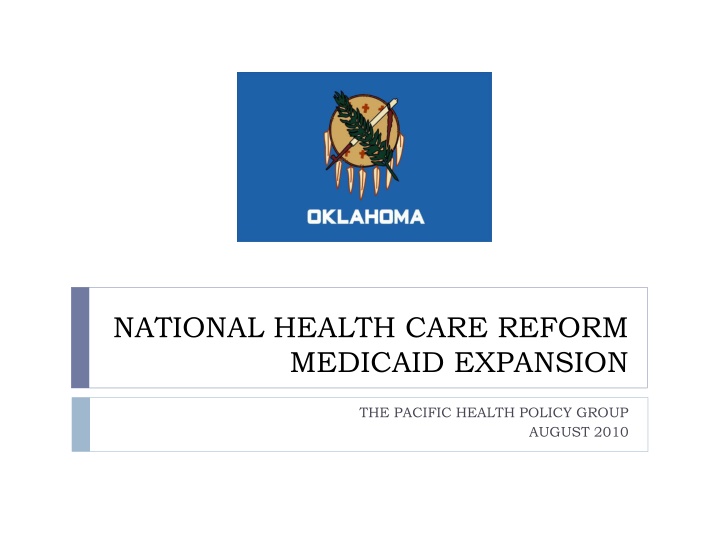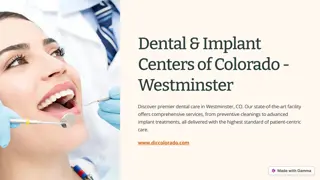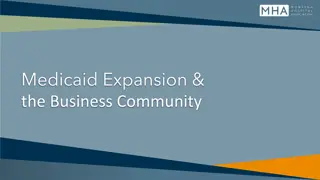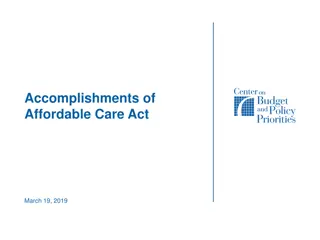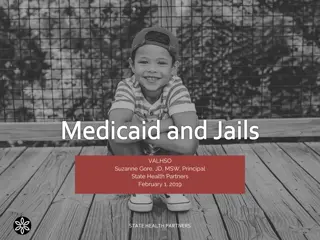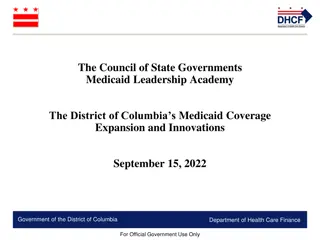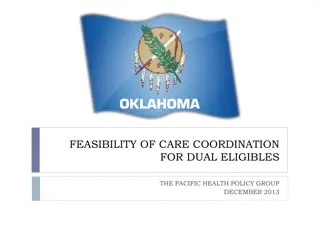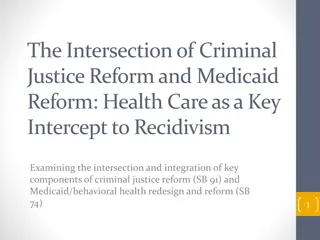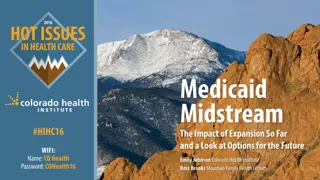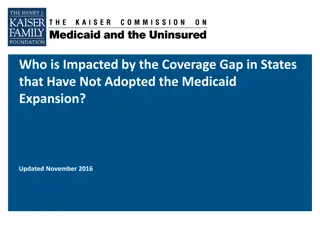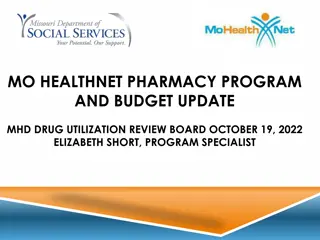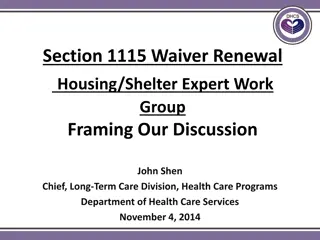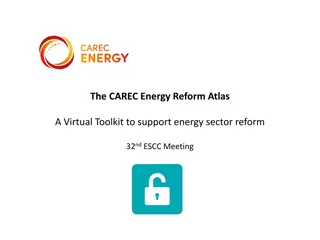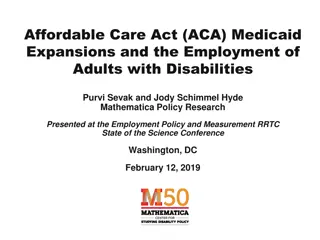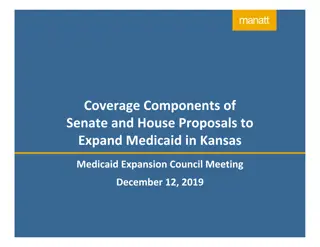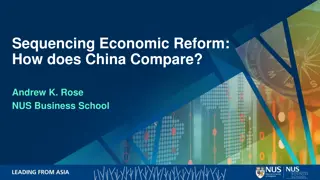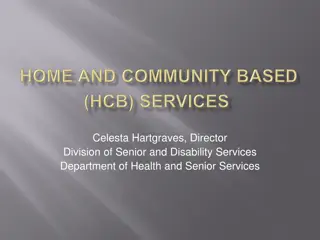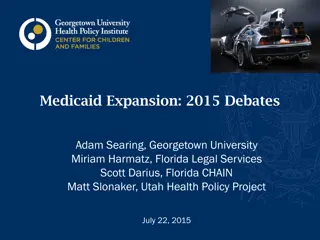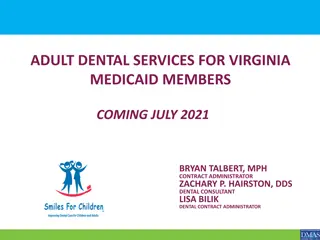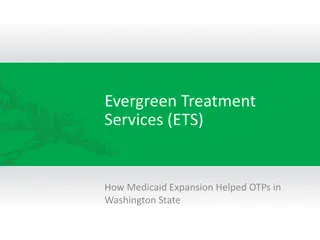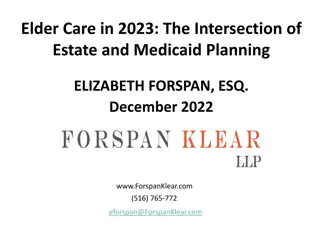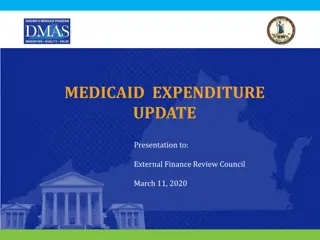National Health Care Reform Medicaid Expansion by Pacific Health Policy Group
This content discusses the Medicaid expansion in relation to the Affordable Care Act, focusing on early expansion options, coverage extensions, funding services, and the involvement of state agencies and programs. It highlights Oklahoma's efforts in providing services for uninsured adults and the considerations for Medicaid enrollment under the SoonerCare program.
Download Presentation

Please find below an Image/Link to download the presentation.
The content on the website is provided AS IS for your information and personal use only. It may not be sold, licensed, or shared on other websites without obtaining consent from the author.If you encounter any issues during the download, it is possible that the publisher has removed the file from their server.
You are allowed to download the files provided on this website for personal or commercial use, subject to the condition that they are used lawfully. All files are the property of their respective owners.
The content on the website is provided AS IS for your information and personal use only. It may not be sold, licensed, or shared on other websites without obtaining consent from the author.
E N D
Presentation Transcript
NATIONAL HEALTH CARE REFORM MEDICAID EXPANSION THE PACIFIC HEALTH POLICY GROUP AUGUST 2010
Affordable Care Act and Medicaid Discussion Topics Undertaking an incremental Medicaid expansion in advance of 2014 Affordable Care Act mandate Offering SoonerCare as an option through OSEEGIB to qualifying low income households PHPG Health Care Reform 2
Affordable Care Act and Medicaid 1902(k)(2) Early Expansion Option Act extends coverage to individuals not otherwise eligible for Medicaid, in households with incomes under 133 percent of FPL (primarily adults without dependent children; in Oklahoma, also non-pregnant parents above 37 percent of FPL) Coverage must be provided beginning in 2014 Coverage may be provided prior to 2014 (at standard FMAP), and can be limited to households below the 133 percent level Option created in part for states with existing non-federally matched programs for uninsured adults Connecticut is the first state to expand coverage, converting a state-funded program covering 45,000 adults PHPG Health Care Reform 3
Affordable Care Act and Medicaid 1902(k)(2) Early Expansion Option Oklahoma funds services for uninsured adults below 133 percent of FPL using state and local (county) dollars Multiple state agencies provide/fund services to the uninsured that would be reimbursable under Medicaid if the individuals were enrolled in SoonerCare Agency* Services (Examples) Primary/preventive care at county health department clinics Oklahoma State Department of Health** Oklahoma State Department of Mental Health & Substance Abuse Services Community Mental Health Center services (including substance abuse treatment) Inpatient hospital services for correctional system inmates Oklahoma Department of Corrections *PHPG also met with representatives from the Oklahoma Department of Rehabilitation Services **County governments also contribute funding toward care provided in health department clinics PHPG Health Care Reform 4
Affordable Care Act and Medicaid 1902(k)(2) Early Expansion Option PHPG is evaluating the potential impact of undertaking an incremental eligibility expansion prior to 2014 Evaluation is being conducted in collaboration with affected state agencies (all data and conclusions are solely the responsibility of PHPG) Any early expansion will involve a trade-off Federal matching of current state-only expenditures, making available additional dollars for reinvestment into the health care system (and improving access to health care) versus Newly-covered individuals not in the system today, whose service costs will result in new state expenditures (state matching dollars) PHPG Health Care Reform 5
Affordable Care Act and Medicaid 1902(k)(2) Early Expansion Option - ODMHSAS ODMHSAS state-only expenditures for services that could be federally matched, if the individual was now eligible for Medicaid, totaled $45.9 million1 in SFY 2010, for adults below 133% of FPL Apportioning the unmatched dollars evenly by poverty percentage (conservative assumption) yields the following in potential federal dollars for reinvestment: Potential Federal Dollars at Standard 2011 FMAP (64.94%) Estimated Current State Expenditure FPL Range 0 to 50% FPL $17.4 million $11.3 million 0 to 100% FPL $34.8 million $22.6 million 0 to 132% FPL $45.9 million $29.8 million 1 Source: DMHSAS (all contact sources) PHPG Health Care Reform 6
Affordable Care Act and Medicaid 1902(k)(2) Early Expansion Option - DOC There were 254 inmate admissions to hospitals other than Lindsay Municipal Hospital in 2009, for a total cost to DOC of $2.8 million Any incremental FPL expansion would likely result in all of these stays being covered under Medicaid. Using the same payment rates, new federal dollars for reinvestment at SFY 2011 standard FMAP would total $1.8 million DOC payment rates are higher than Medicaid in some instances. Paying at Medicaid rates would also have a favorable financial impact There were an additional 696 admissions to Lindsay Municipal Hospital in 2009, some of which could have been made to another hospital, if the result would be coverage under Medicaid. (Any additional revenues would be partly offset by higher correctional officer costs) PHPG Health Care Reform 7
Affordable Care Act and Medicaid SoonerCare and OSEEGIB State employees and education workers are eligible for health insurance through OSEEGIB Employees and dependents are eligible for Medicaid today if they meet categorical requirements Children of employees have not been eligible for CHIP but will be under reform (subject to certain restrictions) Adults without categorical linkages will become eligible for Medicaid under reform if their family income is below 133 percent of FPL PHPG is evaluating the potential impact of offering SoonerCare (Medicaid) as a plan option to employees and spouses in households with incomes below 133 percent of FPL PHPG Health Care Reform 8
Affordable Care Act and Medicaid SoonerCare and OSEEGIB For qualifying employees, the OHCA could evaluate the cost- effectiveness of paying the employee premiums (as permitted under current law) If the private plan premium is not cost effective as compared to Medicaid, the employee would enroll into SoonerCare As an alternative, the federal matching dollars associated with the SoonerCare PMPM amount could be applied toward the employee s premium, with OSEEGIB retaining responsibility for the state match + the remaining gap In either case, the federal matching dollars could be reinvested into the health care system to improve access to care PHPG Health Care Reform 9
Affordable Care Act and Medicaid SoonerCare and OSEEGIB Example Potential Federal Share at Standard 2011 FMAP (64.94%)3 State Share PMPM Difference Option Premium Current Employee enrolls in Health Choice High Option $461.501 --- $461.50 --- Option 1 Employee enrolls in SoonerCare program $353.002 $229.00 $124.00 $229.00 Option 2 Employee remains in Health Choice High Option $124.00 + $108.50 $461.50 $229.00 $229.00 1 2 3 2010 Health Choice employee High Option premium OHCA Individual Plan average adult PMPM for July 2010 Increases to 100% FMAP in 2014 PHPG Health Care Reform 10
Affordable Care Act and Medicaid SoonerCare and OSEEGIB Preliminary Numbers Employee + Dependent Spouse under 133% FPL2 Potential Federal Share at Standard 2011 FMAP (64.94%)3 Total Dollars (OHCA IP PMPM) Agency1 Department of Human Services Department of Tourism & Recreation Department of Veterans Affairs 959 $4.1million $2.6 million 312 $1.3 million $858,000 215 $911,000 $591,000 199 $843,000 $547,000 Department of Health Department of Transportation 198 $839,000 $545,000 671 $2.8 million $1.8 million All Others TOTAL 2,554 $10.8 million $7.0 million 1 2 3 Does not include local educational workers (e.g., teachers and aides), some of whom also would qualify Does not include income from other jobs (does include estimated spousal income) Increases to 100% FMAP in 2014 PHPG Health Care Reform 11
Affordable Care Act and Medicaid SoonerCare and OSEEGIB The policy question for the state is whether/how to inform state employees about the Medicaid option, beyond traditional methods (e.g., including in list of plan offerings) Although there is no apparent prohibition on this step, CMS reaction is uncertain The reaction of other OSEEGIB plans (and some providers) may not be positive, although the introduction of more competition could have a positive effect on commercial plan rates PHPG Health Care Reform 12
